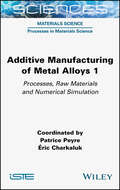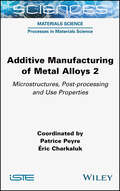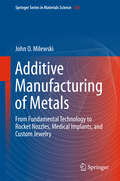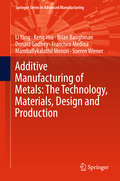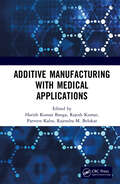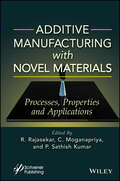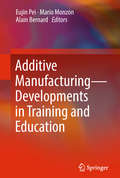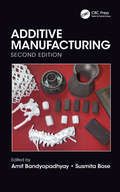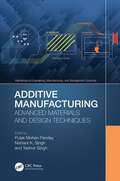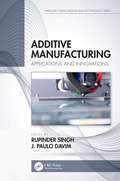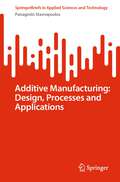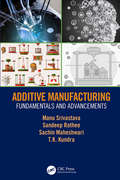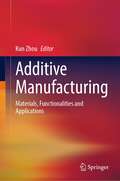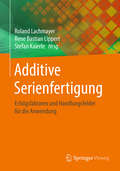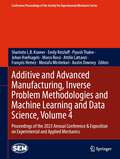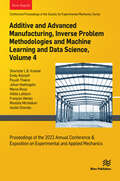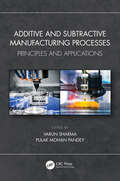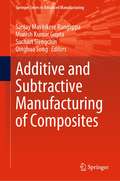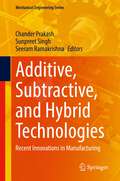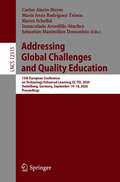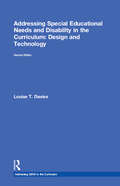- Table View
- List View
Additive Manufacturing of Metal Alloys 1: Processes, Raw Materials and Numerical Simulation
by Patrice Peyre Éric CharkalukOver the last decade or so, additive manufacturing has revolutionized design and manufacturing methods by allowing more freedom in design and functionalities unattainable with conventional processes. This has generated extraordinarily high interest in both industrial and academic communities.Additive Manufacturing of Metal Alloys 1 puts forward a state of the art of additive manufacturing and its different processes, from metallic raw materials (in the form of powder or wire) to their properties after elaboration. It analyzes the physics and the modelling of existing AM processes as well as future elaboration processes.Using a balanced approach encapsulating basic notions and more advanced aspects for each theme, this book acts as a metal additive manufacturing textbook, as useful to professionals in the field as to the general public.
Additive Manufacturing of Metal Alloys 2: Microstructures, Post-processing and Use Properties
by Patrice Peyre Éric CharkalukOver the last decade or so, additive manufacturing has revolutionized design and manufacturing methods by allowing more freedom in design and functionalities unattainable with conventional processes. This has generated extraordinarily high interest in both industrial and academic communities. Additive Manufacturing of Metal Alloys 2 puts forward a state of the art of additive manufacturing and its different processes, from metallic raw materials (in the form of powder or wire) to their properties after elaboration. It analyzes the microstructures and post-processing of existing AM materials as well as their use properties. Using a balanced approach encapsulating basic notions and more advanced aspects for each theme, this book acts as a metal additive manufacturing textbook, as useful to professionals in the field as to the general public.
Additive Manufacturing of Metals: From Fundamental Technology to Rocket Nozzles, Medical Implants, and Custom Jewelry (Springer Series in Materials Science #258)
by John O. MilewskiThis engaging volume presents the exciting new technology of additive manufacturing (AM) of metal objects for a broad audience of academic and industry researchers, manufacturing professionals, undergraduate and graduate students, hobbyists, and artists. Innovative applications ranging from rocket nozzles to custom jewelry to medical implants illustrate a new world of freedom in design and fabrication, creating objects otherwise not possible by conventional means. The author describes the various methods and advanced metals used to create high value components, enabling readers to choose which process is best for them. Of particular interest is how harnessing the power of lasers, electron beams, and electric arcs, as directed by advanced computer models, robots, and 3D printing systems, can create otherwise unattainable objects. A timeline depicting the evolution of metalworking, accelerated by the computer and information age, ties AM metal technology to the rapid evolution of global technology trends. Charts, diagrams, and illustrations complement the text to describe the diverse set of technologies brought together in the AM processing of metal. Extensive listing of terms, definitions, and acronyms provides the reader with a quick reference guide to the language of AM metal processing. The book directs the reader to a wealth of internet sites providing further reading and resources, such as vendors and service providers, to jump start those interested in taking the first steps to establishing AM metal capability on whatever scale. The appendix provides hands-on example exercises for those ready to engage in experiential self-directed learning.
Additive Manufacturing of Metals: The Technology, Materials, Design and Production (Springer Series in Advanced Manufacturing)
by Francisco Medina Li Yang Keng Hsu Brian Baughman Donald Godfrey Mamballykalathil Menon Soeren WienerThis book offers a unique guide to the three-dimensional (3D) printing of metals. It covers various aspects of additive, subtractive, and joining processes used to form three-dimensional parts with applications ranging from prototyping to production. Examining a variety of manufacturing technologies and their ability to produce both prototypes and functional production-quality parts, the individual chapters address metal components and discuss some of the important research challenges associated with the use of these technologies. As well as exploring the latest technologies currently under development, the book features unique sections on electron beam melting technology, material lifting, and the importance this science has in the engineering context. Presenting unique real-life case studies from industry, this book is also the first to offer the perspective of engineers who work in the field of aerospace and transportation systems, and who design components and manufacturing networks. Written by the leading experts in this field at universities and in industry, it provides a comprehensive textbook for students and an invaluable guide for practitioners
Additive Manufacturing of Polymers for Tissue Engineering: Fundamentals, Applications, and Future Advancements (Sustainable Manufacturing Technologies)
by Ankit Sharma Ranvijay Kumar Atul Babbar Vikas Dhawan Nishant RanjanApplication of additive manufacturing and tissue engineering in the fields of science and technology enables the manufacturing of biocompatible, customized, reliable, and cost-effective parts, restoring the functionality of a failed human body part. This book offers a platform for recent breakthroughs in additive manufacturing related to biomedical applications. This book highlights some of the top innovations and advances in additive manufacturing and processing technologies that are the future of the manufacturing industry while also presenting current challenges and opportunities regarding the choice of material. This book includes areas of applications such as surgical guides, tissue regeneration, artificial scaffolds, implants, and drug delivery and release. Throughout the book, an emphasis is placed on rapid tooling for engineering applications. Additive Manufacturing of Polymers for Tissue Engineering: Fundamentals, Applications, and Future Advancements acts as a first-hand source of information for academic scholars and commercial manufacturers as they make strategic manufacturing and development plans.
Additive Manufacturing with Medical Applications
by Rajendra M. BelokarThis reference text discusses integrated approaches to improve the objectives of additive manufacturing in medical application. The text covers case studies related to product design and development, discuses biomaterials, applications of artificial intelligence and machine learning using additive manufacturing techniques. It covers important topics including 3D printing technology, materials for 3D printing in medicine, rapid prototyping in clinical applications, and use of additive manufacturing in customized bone tissue engineering scaffold. The text- Discusses additive manufacturing techniques and their utilization in medical applications. Covers important applications of additive manufacturing in the fields of medicine, education and space industry. Explores regulatory challenges associated with the emergence of additive manufacturing. Examines the use of rapid prototyping in clinical applications. The text will serve as a useful reference guide for graduate students and academic researchers in the fields of industrial engineering, manufacturing science, mechanical engineering, and aerospace engineering. This book discusses important application areas of additive manufacturing, including medicine, education, and the space industry, this reference text will be a serve as a useful text for graduate students and academic researchers in the fields of industrial engineering, manufacturing science, mechanical engineering, and aerospace engineering.
Additive Manufacturing with Metals: Design, Processes, Materials, Quality Assurance, and Applications
by Sanjay Joshi Richard P. Martukanitz Abdalla R. Nassar Pan MichalerisThis textbook and reference provides a comprehensive treatment of additive manufacturing (AM) for metals, including design and digital work flows, process science and reliability, metallic systems, quality assurance, and applications. The book is rooted in the fundamental science necessary to develop and understand AM technologies, as well as the application of engineering principles covering several disciplines to successfully exploit this important technology. As additive manufacturing of metals is the fastest growing subset of this transformative technology, with the potential to make the widest impact to industrial production, Metals Additive Manufacturing: Design, Processes, Materials, Quality Assurance, and Applications is ideal for students in a range of engineering disciplines and practitioners working in aerospace, automotive, medical device manufacturing industries.
Additive Manufacturing with Novel Materials: Process, Properties and Applications
by R. Rajasekar C. Moganapriya P. Sathish KumarADDITIVE MANUFACTURING With NOVEL MATERIALS The book explores practically the latest advancements and techniques in 3D and 4D printing using innovative and unconventional materials. This book comprehensively provides insights into various additive manufacturing processes, novel materials, and their properties, as well as the basic knowledge of AM process parameters, post-processing techniques, and their applications. It also explores the fundamental concepts and recent advancements in the development of novel materials for several applications, with special emphasis on platforms like AM techniques for polymers, ceramics, metallic materials, composites, nanomaterials, hydrogels, etc. Specific topics like environmental aspects of 3D printing and advanced 4D printing are also introduced. The technological aspects of AM are discussed in a concise and understandable way, with extensive illustrations. Also covered are the challenges and opportunities that arise from 3D printing with these materials. Audience The book will benefit researchers and industry engineers who work in additive manufacturing, mechanical engineering, 3D/4D printing, and materials science.
Additive Manufacturing – Developments in Training and Education
by Alain Bernard Eujin Pei Mario MonzónThis book provides an overview of training and teaching methods, as well as education strategies, for Additive Manufacturing (AM) and its application in different business sectors. It presents real-world applications and case studies to demonstrate the key practical and theoretical fundamentals of AM training, written by international experts from the field. Additive Manufacturing is a rapidly developing technology, and having a well-trained workforce is essential. Accordingly, readers are introduced to new training approaches and recent breakthroughs that can facilitate and accelerate the design, application and implementation of AM.The book’s contributors discuss many topics to provide readers a fundamental grasp of AM, including:· collaboration among educational bodies, and between industry and governments;· strategies for implementing AM training;· new teaching methods;· training programs that provide alternative employment choices;· the need for certification by professional bodies; and· promoting awareness of AM in society. This book offers an excellent source of information for researchers and industrial engineers who are interested in expanding their AM expertise, and learning how to implement it. It will also be of interest to readers who want to learn about the practicalities of adopting training and teaching for AM.
Additive Manufacturing, Second Edition
by Susmita Bose Amit BandyopadhyayThe field of additive manufacturing is growing dynamically as the interest is persisting from manufacturing sector, including other sectors as well. Conceptually, additive manufacturing is a way to build parts without using any part-specific tooling or dies from the computer-aided design (CAD) file of the part. Second edition of Additive Manufacturing highlights the latest advancements in the field, taking an application oriented approach. It includes new material on traditional polymer based rapid prototyping technologies, additive manufacturing of metals and alloys including related design issues. Each chapter comes with suggested reading, questions for instructors and PowerPoint slides.
Additive Manufacturing: Advanced Materials and Design Techniques (Mathematical Engineering, Manufacturing, and Management Sciences)
by Yashvir Singh Nishant K. Singh Pulak Mohan PandeyThe text explores the development, use, and effect of additive manufacturing and digital manufacturing technologies for diverse applications. It will serve as an ideal reference text for graduate students and academic researchers in diverse engineering fields including industrial, manufacturing, and materials science. This book: Discusses the application of 3D virtual models to lasers, electron beams, and computer-controlled additive manufacturing machines Covers applications of additive manufacturing in diverse areas including healthcare, electronics engineering, and production engineering Explains the use of additive manufacturing for biocomposites and functionally graded materials Highlights rapid manufacturing of metallic components using 3D printing Illustrates production and optimization of dental crowns using additive manufacturing This book covers recent developments in manufacturing technology, such as additive manufacturing, 3D printing, rapid prototyping, production process operations, and manufacturing sustainability. The text further emphasizes the use of additive manufacturing for biocomposites and functionally graded materials. It will serve as an ideal reference text for graduate students and academic researchers in the fields of industrial engineering, manufacturing engineering, automotive engineering, aerospace engineering, and materials science.
Additive Manufacturing: Applications and Innovations (Manufacturing Design and Technology)
by Rupinder Singh and J. Paulo DavimThere has been a great deal of progress in additive manufacturing (AM) during the past two decades and recent developments have been highlighted by many researchers. However, until now, there has been a limit to what is available for beginners in a step-by-step format, showcasing the different commercial AM technologies for field application. This book helps fill that gap. Additive Manufacturing: Applications and Innovations presents case studies of commonly used AM technologies with basic numerical problems for better understanding. It also includes hybrid processes and 4D printing applications, which currently are not offered in other AM books. Features Offers solved and unsolved problems in additive manufacturing Provides an understanding for additive manufacturing per international standards Includes case studies for better understanding of the individual processes Presents a review of specific technology highlights Introduces future research directions, mainly in 4D printing applications
Additive Manufacturing: Design, Processes and Applications (SpringerBriefs in Applied Sciences and Technology)
by Panagiotis StavropoulosThis book is a comprehensive guide to Additive Manufacturing (AM) product development. It offers a practical, reader-friendly approach to integrating the stages of product development. It covers current design and manufacturing strategies with a step-by-step approach, divided into three pillars: design, processes, and applications.The book addresses the challenges hindering the industrial application of AM and provides a roadmap for its successful implementation. It discusses specific AM case studies and hybrid AM cell and production line setups, with the goal of achieving high-quality, low-cost products that are both flexible and productive. The book concludes with an examination of Industry 4.0 capabilities in decentralized manufacturing.It is aimed to be read by researchers and professionals in industry who are interested in the development and potential of additive manufacturing, and will help to lead to wider adoption of AM.
Additive Manufacturing: Fundamentals and Advancements
by Sandeep Rathee Manu Srivastava Sachin Maheshwari Tk KundraThere is a growing need for manufacturing optimization all over the world. The immense market of Additive Manufacturing (AM) technologies dictates a need for a book that will provide knowledge of the various aspects of AM for anyone interested in learning about this fast-growing topic. This book disseminates knowledge of AM amongst scholars at graduate level, post graduate level, doctoral level, as well as industry personnel. The objective is to offer a state-of-the-art book which covers all aspects of AM and incorporates all information regarding trends, historical developments, classifications, materials, tooling, software issues, dynamic design, principles, limitations, and communication interfaces in a one-stop resource. Features: Breaks down systematic coverage of various aspects of AM within four distinct sections Contains details of various AM techniques based on ASTM guidelines Discusses many AM applications with suitable illustrations Includes recent trends in the field of AM Covers engineering materials utilized as raw materials in AM Compares AM techniques with different traditional manufacturing methods
Additive Manufacturing: Innovations, Advances, and Applications
by T. S. Srivatsan T. S. SudarshanGet Ready for the Future of Additive ManufacturingAdditive Manufacturing: Innovations, Advances, and Applications explores the emerging field of additive manufacturing (AM)-the use of 3D printing to make prototype parts on demand. Often referred to as the third industrial revolution, AM offers many advantages over traditional manufacturing. This pr
Additive Manufacturing: Materials, Functionalities and Applications
by Kun ZhouThis book focuses on the advances of additive manufacturing in the applications of wearable electronics, energy storage, biomedical implants and devices, drug delivery, and technologies for 4D printing, large-scale printing, and ceramics printing. It provides timely insights into the materials, functionalities, and applications of additive manufacturing.
Additive Serienfertigung: Erfolgsfaktoren und Handlungsfelder für die Anwendung
by Roland Lachmayer Rene Bastian Lippert Stefan KaierleBei der additiven Fertigung wird anders als bei konventionellen Verfahren ein Bauteil nicht aus einem Block herausgefräst oder in einem Werkzeug gegossen, sondern es wird Schicht für Schicht generiert. Dieses Buch stellt eine Vielzahl verschiedener Aspekte der additiven Fertigung vor und erläutert anhand von Praxisbeispielen die Anwendungen und die Potenziale der Verfahren für eine Serienfertigung: Wo und wie kann die additive Fertigung erfolgreich eingesetzt werden?Die Autoren zeigen vor dem Hintergrund eines ganzheitlichen Entwicklungs- und Fertigungsprozesses mögliche Geschäftsmodelle auf, unter anderem die Fertigung in Microfactories. Leser erfahren, wie sich die Fertigungszeit und -kosten vorhersagen lassen, wie zuverlässig additiv gefertigte Strukturbauteile sind und inwieweit additive Fertigungsverfahren für die Herstellung von Endprodukten geeignet sind.Ferner diskutieren die Autoren, wie Pre- und Post-Prozesse genutzt werden können, um Serienanwendungen zu etablieren und diese iterativ zu verbessern. Neben den Möglichkeiten zur Qualitätssicherung bei der additiven Serienfertigung wird erläutert, wann es sinnvoll sein kann, konventionelle Fertigungsverfahren durch hybride Ansätze zu ergänzen. Die additive Instandsetzung als Alternative zum Entsorgen von verschlissenen Bauteilen wird ebenfalls erörtert. Im Hinblick auf eine Effizienzsteigerung diskutieren die Autoren Sicherheitsaspekte und legen Lösungsansätze bei Problemen im Umgang mit der additiven Serienfertigung dar.
Additive and Advanced Manufacturing, Inverse Problem Methodologies and Machine Learning and Data Science, Volume 4: Proceedings of the 2023 Annual Conference & Exposition on Experimental and Applied Mechanics (Conference Proceedings of the Society for Experimental Mechanics Series)
by Marco Rossi Sharlotte L. B. Kramer Johan Hoefnagels François Hemez Emily Retzlaff Piyush Thakre Attilio Lattanzi Mostafa Mirshekari Austin DowneyAdditive and Advanced Manufacturing, Inverse Problem Methodologies and Machine Learning and Data Science, Volume 4 of the Proceedings of the 2023 SEM Annual Conference & Exposition on Experimental and Applied Mechanics, the fourth volume of five from the Conference, brings together contributions to this important area of research and engineering. The collection presents early findings and case studies on a wide range of topics and includes papers in the following general technical research areas: AM Composites and Polymers Dynamic Behavior of Additively Manufactured Materials and Structures Joint Residual Stress and Additive Manufacturing ML for Material Model Identification Novel AM Structures Novel Processing and Testing of Additively Manufactured Materials Plasticity and Complex Material Behavior Virtual Fields Method
Additive and Advanced Manufacturing, Inverse Problem Methodologies and Machine Learning and Data Science, Volume 4: Proceedings of the 2023 Annual Conference on Experimental and Applied Mechanics
by Marco Rossi Johan Hoefnagels François Hemez Emily Retzlaff Piyush Thakre Attilio Lattanzi Mostafa Mirshekari Austin Downey Kramer, Sharlotte L. BAdditive and Advanced Manufacturing, Inverse Problem Methodologies and Machine Learning and Data Science, Volume 4 of the Proceedings of the 2023 SEM Annual Conference & Exposition on Experimental and Applied Mechanics, the fourth volume of five from the Conference, brings together contributions to this important area of research and engineering. The collection presents early findings and case studies on a wide range of topics and includes papers in the following general technical research areas: AM Composites and Polymers Dynamic Behavior of Additively Manufactured Materials and Structures Joint Residual Stress and Additive Manufacturing ML for Material Model Identification Novel AM Structures Novel Processing and Testing of Additively Manufactured Materials Plasticity and Complex Material Behavior Virtual Fields Method.
Additive and Subtractive Manufacturing Processes: Principles and Applications
by Varun Sharma Pulak Mohan PandeyThis reference text discusses fundamentals, classification, principles, applications of additive and subtractive manufacturing processes in a single volume. The text discusses 3D printing techniques with the help of practical case studies, covers rapid tooling using microwave sintering and ultrasonic assisted sintering process, and covers different hybrid manufacturing techniques like cryo-MQL, and textured cutting inserts. It covers important topics including green manufacturing, ultrasonic assisted machining, electro thermal based non-conventional machining processes, metal based additive manufacturing, LASER based additive manufacturing, indirect rapid tooling, and polymer based additive manufacturing. The book- Discusses additive and subtractive manufacturing processes in detail. Covers hybrid manufacturing processes. Provides life cycle analysis of conventional machining. Discusses biomedical and industrial applications of additive manufacturing. The text will be useful for senior undergraduate, graduate students, and academic researchers in areas including industrial and manufacturing engineering, mechanical engineering, and production engineering. Discussing the sustainability aspects of conventional machining in reducing carbon footprint of machining by adopting different hybrid and non-conventional machining processes, this text will be useful for senior undergraduate, graduate students, and academic researchers in areas including industrial and manufacturing engineering, mechanical engineering, and production engineering.
Additive and Subtractive Manufacturing of Composites (Springer Series in Advanced Manufacturing)
by Munish Kumar Gupta Suchart Siengchin Sanjay Mavinkere Rangappa Qinghua SongThis book describes crucial aspects related to the additive and subtractive manufacturing of different composites. The first half of this book mainly deals with the various types of composite fabrication methods along with the introduction, features and mechanisms and also the processing of composite materials via additive manufacturing route. Also, the thermal, mechanical, physical and chemical properties relevant to the processing of composite materials are included in the chapters. The second half of this book primarily demonstrates an extensive section on the different types of additive manufacturing processes like selective laser sintering, selective laser melting, stereolithography, fused deposition modeling and material jetting used to fabricate the metals and polymers. Also, the chapters address the complete description of fabrication processes for metal matrix composites and polymer matrix composites. Moreover, the different methods adopted such as short peening, micro-machining, heat-treatment and solution treatment to improve the surface improvement are well discussed. This book gives many helps to researchers and students in the fields of the additive and subtractive manufacturing of different composites.
Additive, Subtractive, and Hybrid Technologies: Recent Innovations in Manufacturing (Mechanical Engineering Series)
by Seeram Ramakrishna Chander Prakash Sunpreet SinghThis book provides readers with the comprehensive insights of the recent research breakthroughs in additive, subtractive, and hybrid technologies. Further, the book examines incomparable design and manufacturing independences, as well as strategies to upgrade the product performance characteristics through collaborating additive and subtractive technologies. Indeed, the intrinsic benefits and limitations of both additive and subtractive manufacturing technologies could be merged to obtain appreciable hybridizations. The editorial team members and contributors to Additive, Subtractive, and Hybrid Technologies are highly motivated experts committed to and the advance of hybrid manufacturing technologies.
Addressing Emerging Trends to Support the Future of Criminal Justice: Findings of the Criminal Justice Technology Forecasting Group
by Richard Silberglitt Brian A. Jackson John S. Hollywood Dulani Woods Andrew LaulandThe Criminal Justice Technology Forecasting Group (CJTFG) deliberated on the effects that major technology and social trends could have on criminal justice in the next two to five years and identified potential responses. This report captures the results of the group’s meetings and initiatives, presents the emerging trends and highlights of the group’s discussion, and presents the results of analyses to assess connections between the trends.
Addressing Global Challenges and Quality Education: 15th European Conference on Technology Enhanced Learning, EC-TEL 2020, Heidelberg, Germany, September 14–18, 2020, Proceedings (Lecture Notes in Computer Science #12315)
by Maren Scheffel María Jesús Rodríguez-Triana Carlos Alario-Hoyos Inmaculada Arnedillo-Sánchez Sebastian Maximilian DennerleinThis book constitutes the proceedings of the 15th European Conference on Technology Enhanced Learning, EC-TEL 2020, held in Heidelberg, Germany, in September 2020. The 24 research papers and 20 demo and 5 poster papers presented in this volume were carefully reviewed and selected from 91 submissions. The European Conference on Technology-Enhance Learning, which celebrates its 15th anniversary this year, is committed to address global challenges and quality education. The papers deal with the Sustainable Development Goals, particularly SDG 4 and SDG 10, to help to reduce the existing gaps and inequalities between countries and regions from around the world in terms of inclusiveness, equity, access, and quality of education.The chapters: “Designing an Online Self-Assessment for Informed Study Decisions: The User Perspective”; “Living with Learning Difficulties: Two Case Studies Exploring the Relationship Between Emotion and Performance in Students With Learning Difficulties”; “Applying Instructional Design Principles on Augmented Reality Cards for Computer Science Education”; and “Teaching Simulation Literacy With Evacuations - Concept, Technology, and Material for a Novel Approach” are available open access under a Creative Commons Attribution 4.0 International License via link.springer.com. Due to the Corona pandemic EC-TEL 2020 was held as an virtual event.
Addressing Special Educational Needs and Disability in the Curriculum: Design And Technology (Addressing SEND in the Curriculum)
by Louise T. DaviesThe SEND Code of Practice (2015) reinforced the requirement that all teachers must meet the needs of all learners. This topical book provides practical, tried-and-tested strategies and resources that will support teachers in making design and technology lessons accessible and interesting for all pupils, including those with special educational needs. The author draws on a wealth of experience to share her understanding of special educational needs and disabilities and show how the design and technology teacher can reduce or remove any barriers to learning. Offering strategies that are specific to the context of design and technology teaching, this book will enable teachers to: better identify a student’s particular learning requirements; set inclusive design and making assignments which allow all students to participate and succeed; build students’ confidence in using a range of materials and tools; assist with design tasks where pupils take ownership of their work and learning; adapt the classroom environment to meet the needs of pupils; create a mutually supportive classroom which maximises learning opportunities. An invaluable tool for continuing professional development, this text will be essential for design and technology teachers (and their teaching assistants) seeking to include and motivate all pupils in their lessons, regardless of their individual needs. This book will also be of interest to secondary SENCOs, senior management teams and ITT providers. In addition to free online resources, a range of appendices provide design and technology teachers with a variety of pro forma and activity sheets to support effective teaching. This is an essential tool for design and technology teachers and teaching assistants, and will help to deliver successful, inclusive lessons for all pupils.
